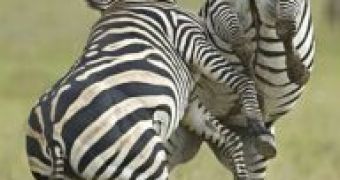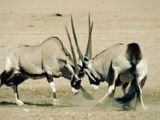When it's about rank and power, brute force rarely reaches the goal. In most cases, tactics is more effective.
We, people, do know it, but much to our surprise, animals are ruled by the same rules.
When two zebra stallions are fighting, you can be sure it's not for the rights over a harem. The mares are so faithful to their "master" that such a fight would be useless.
Young zebras fight for rank, and they follows strict rules: the two pretenders assess carefully their chances and risks, and they have to choose their weapons: biting or kicking. Both variants can lead to severe wounds that would make them easy preys for the lions.
When he is attacked, a young stallion is very aware and in the beginning, he bends on his knees. This position decreases his risks, but also his chances of winning, because on his knees, he will never be able to dominate his adversary. A more offensive tactic would be to stay on its hind legs to bite and kick its adversary from the upper part.
So why doesn't the younger adversary do the same thing from the beginning?
Observations revealed that if he tries this type of fight, it's very probable that the he won't manage the hit, and the other will catch the moment to inflict an extremely severe wound. So that the younger will choose for the beginning a less dangerous tactic.
With their horns like sabres, gemsbok antelopes are extremely dangerous. There were observed countless cases when these animals simply stabbed lions with their horns. But between themselves, these antelopes rarely use their horns as deadly weapons.
The adversaries duel in a fair-play contest, in which they won't reach other with the extremely poignant tip of their horns. But some of these antelopes can not stand the defeat and won't give up the fight, even if one is weaker.
In this case, the winner ends the fight by turning to aggressiveness: he will point his adversary with the tip of his horns, wounding him.
Rhinos have a fame of being fierce, but their fights are almost never bloody. After a fight, the defeated is not even chased away from the territory; he simply loses the right to mate.
In geese, without any apparent reason, in their third week of life amongst the individuals starts a general confrontation. The males fight in pairs, they peak and hit with the wings till one cedes. Each fights against each.
Who will be the chief of the geese flock?
The chance in their case is decisive.
If a strong individual happens to fight with the strongest one in the first fight, the defeat will demoralize him so much, that he will lose the next fight, too, even with a weaker adversary. This new defeat totally paralyzes his guts, and finally it will be amongst the lowest in rank. And vice versa, the weaker ones, that have the luck to fight in the first round with a scraggy one, develops such an aggressiveness that he will defeat even more powerful adversaries.
This is the type of winner, which soon will be the strongest.

 14 DAY TRIAL //
14 DAY TRIAL // 
